INDUSTRIAL &
TERMINAL RAILROADS &
RAIL-MARINE OPERATIONS
OF BROOKLYN, QUEENS, STATEN
ISLAND, BRONX &
MANHATTAN:
NORTH 1ST
/ FIRST STREET FREIGHT
STATION & RAILROAD
Williamsburg, Brooklyn
BALTIMORE & OHIO
RAILROAD;
NEW YORK, NEW HAVEN &
HARTFORD RAILROAD
PRR
|
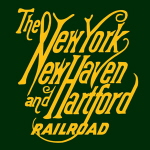 |
..
updated: |
||
|
|
||
| Oct 20, 1918 Brooklyn Daily Eagle article
on merchants protest on closing B&O locomotive photos added, page indexed |
14 March 2010 | |
| created | 03 March 2009 | |
.
.

| Baltimore & Ohio RR: 1890 - 1898 |
New York, New Haven & Hartford RR 1898 - 1918 |
||
| Freight Locomotive Overview |
Potential Freight Locomotive Roster: NYNH&H |
Marine Equipment |
.
.
.
.
While researching Palmer's Docks and upon viewing the 1899 E. Belcher Hyde Map of Williamsburg, Brooklyn; I took note of a isolated amount of trackage at the foot of North 1st Street.
This trackage was located too far south to be part of Lowell Palmer's operation, and no markings on the map indicated the occupant or tenant of this property.
Upon reviewing an E. Belcher Hyde Map of 1916 however, the tracks are gone from the property, but the pier is marked for the New York, New Haven & Hartford Railroad!
It was then subsequently learned from a New York Times newspaper article that this property was originally owned or rented by the Baltimore & Ohio Railroad.
The dates of service for this offline terminal have not yet definitively been ascertained, but appears to be:
.
Baltimore & Ohio Railroad: |
ca. 1890 - ca. 1898 |
| New York, New Haven & Hartford Railroad: | ca. 1898 - 1918 |
.
.
Not counting pier stations, this would be the New York, New Haven & Hartford Railroads's only offline terminal as Oak Point and Bay Ridge would be connected to the main land rail network.
Nothing is confirmed at this time, but it is left to ponder if the New York, New Haven & Hartford Railroad relinquished their presence in Williamsburg to take advantage of the Bay Ridge facility, which was larger, more modern, and was equipped with four float bridges and eventually connected to the mainland rail network in 1916 upon the completion of the Hell Gate Bridge.
Tom Flagg also points out, that offline railroad terminal operations inherently cost more to operate. With Brooklyn Eastern District Terminal only four blocks north, perhaps the New York New Haven & Hartford Railroad could not justify the expenses of operating this terminal, even though their tugboats and carfloats would pass this location enroute to their Oak Point Facility in the Bronx.
Also, it should be noted that neither the Baltimore & Ohio or the New York, New Haven & Hartford Railroad leased property or space at Palmer's Docks (North 5th through North 10th Streets), as would the other railroads: New York Central & Hudson River, New York Lake Erie & Western (Erie), or Central Railroad of New Jersey. The Pennsylvania Railroad had their own terminal located at North 4th Street.
Tom Flagg is in the process of researching the tariff books and further information should be forthcoming.
.
Property & Trackage -
Baltimore & Ohio Railroad: 1890 - ca. 1898
.
This offline terminal located at North 1st Street would be due south of Palmer's Docks / Brooklyn Eastern District Terminal (North 5th through North 10th Streets) and the Pennsylvania North 4th Street Freight Station.
This property would be bound by North 1st Street on the north, River Street on the East and the East River on the west property lines. It is understood that this terminal property did not occupy the entire block, nor extend all the way south to Grand Street, as the Houston Street Ferry Terminal occupied a part of this tax block (#2376) as well.
In the 1886 E. Robinson property map seen below, nothing notes the presence of a railroad terminal or trackage. The northern part of the property at this early date housed a planing mill and the southern part the Ferry Terminal. Also, take note there is no pier at the foot of North 1st Street. (I have listed this map here so that the reader can be better acquainted with the history of the property).
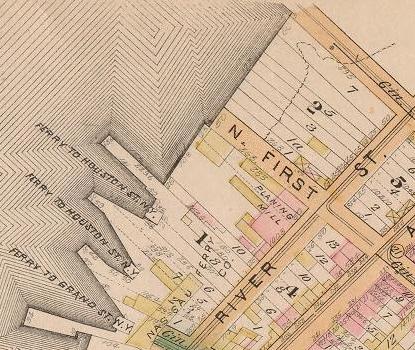
1886 E. Robinson Property Map
NYPL Digital Archives
.
.
| The New York Times newspaper article dated September 24,
1890 (see here at right); mentions that the Baltimore & Ohio Railroad
purchased a piece of property at the foot of North 1st Street, with the intent
of constructed sheds.
From the tone of this article, it is implied that this North 1st Street location operated in some conjunction with the St. George Terminal in Staten Island, and existed prior to the date of this article! What is great about this article, is that it is quite informative: it lists the yard capacity (50 cars), the pier dimensions (42 x 241 feet), the length of the float bridge (90 feet), and that the terminal will be used jointly with Philadelphia & Reading, and Central Railroad of New Jersey. No mention is made of the New York, New Haven & Hartford Railroad, so by this I conclude that the North 1st Street Terminal was not a joint venture. Just a Coincidence? Just as interesting, is that these three railroads (Baltimore & Ohio, Central Railroad of New Jersey and the Philadelphia & Reading Railroads) are the same exact three railroads that leased a freight depot in the North 7th Street of Palmer's Docks (and subsequently the Brooklyn Eastern District Terminal)! So far, we have been able to ascertain that the Baltimore & Ohio, Central Railroad of New Jersey and the Philadelphia & Reading Railroads leased that freight shed on North 7th Street from around 1905 (1902?) through an unknown date prior to 1920, as the shed had been razed by 1920 Subway Contract Photo.
|
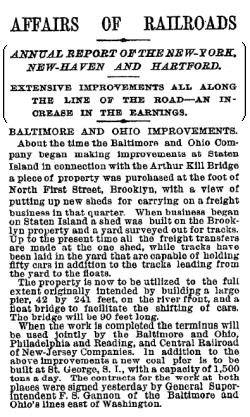 New York Times - September 24, 1890 |
So the question is, did the Baltimore & Ohio Railroad (along with the central Railroad of New Jersey and the Philadelphia & Reading Railroad) move into the freight depot at Palmers Dock around 1905 (1902?), leaving and subsequently selling or leasing the North 1st Street location to the New York, New Haven & Hartford Railroad?.
Also I have noticed that the New York, New Haven & Hartford Railroad did not lease space from Palmer's Docks or Brooklyn Eastern District Terminal during this time frame.
Therefore it is my belief, (however unconfirmed at this time), that the Baltimore & Ohio Railroad leased the freight depot from and moved up to Palmer's Docks, around 1902 - 1905, while the New York, New Haven & Hartford Railroad moved into the North 1 Street location this date through about 1920.
The article at right, also contains information on the "Annual Report of the New-York, New-Haven And Hartford". These paragraphs dealt with improvements in Connecticut, which I have removed to save space here and did not pertain to the North 1st Street location.
Ultimately, the initial presence of the Baltimore & Ohio
Railroad at this North 1st Street location is unexpected and raises further
questions as to the New York, New Haven & Hartford Railroads' occupancy;
i.e.:
.
when did the New York, New Haven & Hartford Railroad take up residence at this location, and
why did the Baltimore & Ohio Railroad give it up (by 1902, judging from the Department of Docks atlas below), and
when did this facility become a pier station only?, etc.
.
. So, I find it more than a coincidence that the Baltimore & Ohio Railroad appeared at the Palmer's Dock location about the same year it left this North 1st Street, but unfortunately, I have nothing at this time more conclusive than my beliefs.
At the least, this article gives us a general idea as to the date a railroad or railroads, began occupying the property located at North 1st Street.
As such, it is apparent that the Baltimore & Ohio Railroad must have either sold or leased the property to the New York New Haven & Hartford Railroad at a date between 1890 and 1898 or perhaps a few years after (ca. 1902 - 1905?).
Upon learning of this Baltimore & Ohio presence, I solicited the assistance of Ed Bommer, a Baltimore & Ohio Railroad historian; to possibly shed some light on this Baltimore & Ohio Facility. Ed replied with the following:
Now that IS very interesting! I had not heard of it until you shared that NY Times article. But as I thought it over, in a way it may have made sense in 1890 for the B&O to establish a direct link to Brooklyn.
Here is what I mulled over about it, with what we already know:
The West 26th Street Yard in Manhattan was B&O's first freight house in New York City. No doubt B&O desired other contact points as well, so it could offer direct freight rates. Brooklyn and Queens being separate cities at that time, Brooklyn as the largest city in the USA with a huge manufacturing capacity. This would have made getting an active rail freight station there all the more attractive. A pier and warehouse to start with, then a carfloat dock so cars could be loaded on site, with a direct B&O freight rate offered. Competition was keen and the hope of building traffic from busy Brooklyn was foremost.
By February 1896 the B&O was in bankruptcy. It was building the St. George Ferry Terminal, which was the largest combined rail, pedestrian, carriage, wagon, and street car terminal in the USA at the time. It could well be that the Brooklyn Eastern District Terminal with its larger facilities and multi-road freight connections put B&O at a disadvantage in Brooklyn. So the North 1st Street property with its warehouse, pier, carfloat dock and yard may have been sold to the New Haven as the bankruptcy sorting-out progressed. Later in 1896, New York was consolidated into the five-borough city we know today. So perhaps a separate B&O presence in Brooklyn for a direct freight rate would no longer be of such importance.
I hope my comments may be of some help. They are conjecture, I realize. It is difficult if not impossible to find B&O documentation from this period because of the great Baltimore fire that destroyed the B&O offices and a large amount of company records.
Best wishes always,
Ed
.
Ed raises a very good point. With the Baltimore & Ohio Railroad being financially strapped.in 1896, logic dictates they would dispose of those properties that were limited in income and resources. Obviously, with Palmer's Dock and the Pennsylvania RR just three blocks north, the Baltimore & Ohio Railroad Freight Station at North 1st Street was in all likelihood, not a overwhelming cash cow.
As can be ascertained from the 1899 Hyde Map (seen below left), there was now a float bridge and team trackage at this terminal, and a structure located along River Street. But no railroad is noted, so we cannot tell if this map represents occupancy by the Baltimore & Ohio or New York New Haven & Hartford.
The map legend denotes this structure to be an "iron covered building" which could mean a sheet metal covered wood frame structure.
Trackage forming a 180 degree curve doff the float bridge and doubled back west onto another small pier due south of the float bridge.
Trackage off the float bridge turned 90 degrees to the south to comprise of a team yard, and a track heading west off the float bridge lead was laid apparently upon the main pier which was constructed by this date at the foot of North 1st Street.
The map does not denote any structure upon the North 1st Street Pier, so it is believed this was an open pier track.
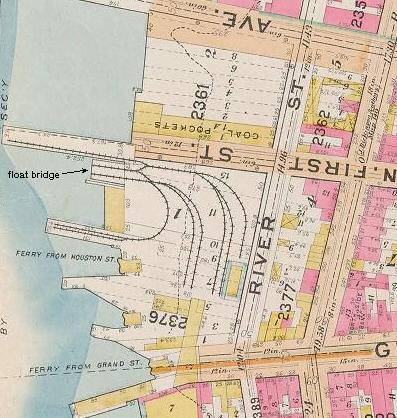
1898 - 1899 Hyde
NYPL Digital Archives
.
.
Property & Trackage - New
York, New Haven & Hartford Railroad: 1898 - 1918
Some interesting documents were located via Google Book search in researching this facility and the date at which the New York, New Haven & Hartford may have begun occupying this location.
The name "Ireland Real Estate Company" has appeared several times during searches of this property as well, and at first, it was not understood why.
The first document, located in the "Thirtieth Annual Report of the Department of Docks and Ferries", for the year ending December 31, 1900, lists:
Foot of North First Street.
Secretary's Order No. 20091.— Repairs were
made to pier thereat by the Ireland Real Estate Company under permit.
Begun May 15 and finished June 2, 1900.
.
Mentioned in the Forty-First Annual Report of the Board of Railroad Commissioners, 1910;
"the New York, New Haven & Hartford Railroad constructed a new pier at "1st Street", Brooklyn at a cost of $4,113.70."
.
In the "Report of the Commissioner of Corporations of Transportation By Water In the United States, Part III, Water Terminals; issued September 26, 1910; shows that the occupant of the pier located at North 1st Street, East River, Brooklyn was
"E. M. Cooke & Company, (private property)."
. (Cooke I believe to be a misspelling of Cook, as members of the Cook family: Carleton Sprague, George I., Walter and Walter Jr. were the principals of the Ireland Real Estate Company.)
.
In the "Thirty-Ninth Annual Report of the Department of Docks & Ferries, for the year ending December 31, 1910; it states:
"The pier at this locality is being rebuilt by the
New York, New Haven & Hartford R.R. Co. under permit from this department.
Work was begun August 9, 1910 and is progress.
.
Another document, is from the "New York Supplement, Volume 131" (New York State Reporter, Volume165) and contains the decisions of the Supreme and Lower Courts of Record of New York State.
It better explains the appearance of the Ireland Real Estate Company. I have highlighted key bits of information in red:
IRELAND REAL ESTATE CO. v. NEW YORK, N. H. & H. R. CO. (City Court of New York, Trial Term. June, 1911.) LANDLORD AND TENANT (§ 330*)-LEASE-QUIET POSSESSION-BREACH OF COVENANTS. A lessor covenanted that the lessee might peaceably enjoy the demised premises, which consisted of lands fronting on navigable waters, lands under water contiguous thereto, and rights of wharfage and cranage without any hindrance from the lessor except in respect of any action which might be taken by the city or state of New York or the United States, Held, that the covenant was not broken by the act of the commissioner of docks of the city of New York in revoking a permit previously given to the lessee to build a pier on the premises because of a claim of a third party to ownership of part of the premises, where the permit is restored within 10 days. [Ed. Note.-For other cases, see Landlord and Tenant, Cent. Dig. |§ 470-481; Dec. Dig. § 130.*] Action by the Ireland Real Estate Company against the New York, New Haven & Hartford Railroad Company. Judgment for plaintiff. Henry Thompson, for plaintiff. Charles M. Sheafe, Jr., for defendant. FINELITE, J. This action was brought to recover a balance unpaid of one-quarter's rent due under an instrument in writing executed between the parties hereto. At the conclusion of the trial had herein, the plaintiff moved for a direction in his favor for the sum of $362.06, inclusive of interest, for the balance due said plaintiff for said rent. The court granted the motion. The defendant then moved to set aside the verdict as directed and for a new trial on all the grounds set forth in section 999 of the Code of Civil Procedure. The court thereupon stated that it would entertain a motion for a new trial on the law involved therein. The plaintiff is a corporation organized and existing under the laws of the state of New York, and defendant is a corporation organized under the laws of the state of Connecticut. By an instrument in writing dated the 17th day of September, 1908, duly executed between the parties hereto, the plaintiff leased to the defendant- "all that certain lot, piece or parcel of land and bulkhead, situate, lying and being in the borough of Brooklyn, city, county and state of New York, and that part which was lately In the city and formerly the village of Williamsburgh, in the county of Kings, state of New York, described as follows: Beginning at the southwesterly corner of River and North First streets; and running thence southerly, along River street, one hundred and fifty-four feet to land of Nassau Ferry Company; thence westerly, along land of said Nassau Ferry Company, to the East River; thence northerly, along the bulkhead on said river, one hundred and thirty-nine feet to North First street: and thence easterly, along North First street, two hundred and eighty-three feet to said southwesterly corner of River and North First streets, at the point or place of beginning, be the said several dimensions more or less; and also all the rights of the said parties of the first part to all wharfage, dockage and cranage upon or in front of said premises on the East River, and also upon or In front of that part of North First street extending along said East River, about thirty-six feet from the southerly side of said street, with the appurtenances. To have and to hold to said premises hereby demised or expressed so to be, with the appurtenances, to the said defendant, its successors and assigns for the term of ten (10) years from the 1st day of October, 1908, with the option and privileges to the said defendant upon giving notice in writing to the plaintiff of its Intention to avail itself of said option or privilege at least eighteen (18) months before the expiration of said term or renewal thereof of two further terms of ten (10) years each from the expiration of last preceding term of tea years, upon the conditions and covenants hereinbefore expressed." Then follows: "The rental to be at the sum of $13,500 per year for the first ten years, to be paid in installments of $3,375 each quarterly, in advance, on the 1st day of October, January, April and July, during the whole of said term, etc., " * and by said lease the defendant covenanted (paragraph 2) to pay rent on the days of payment without any deductions * " * and by paragraph 4 agreed to comply with all rules, ordinances, laws and regulations of the city of New York and of any and all of its departments and bureaus applicable in and to the said premises * and by paragraph 7 plaintiff covenanted and agreed with the defendant, on said defendant fully performing all of the covenants and agreements as aforesaid, it may peaceably and quietly have, hold and enjoy the said demised premises without any let, suit, trouble or hindrances of or from the said plaintiff * * * except in respect of any action which may be taken by or on behalf of the city or State of New York or the government of the United States." Thereafter, and on December 29, 1908, a supplemental agreement was executed between the parties, being supplemental to said lease in respect solely to include any right, title, and interest of the plaintiff in and to lands under water in front of or adjacent to said premises in said indenture bearing date the 17th day of September, 1908, demised and leased as aforesaid. On February 26, 1910, a further agreement was made and executed between the parties, and is herein in extenso set out as follows: "The rent reserved in the within lease is hereby reduced seven (7) per cent, throughout the whole term as an equitable allowance for shortage of eleven (11) feet or thereabouts on the northerly edge of the premises and four (4) feet or thereabouts on the southerly edge of the premises. All of the terms and conditions in this lease and in the supplemental agreement dated December 29, 1908, are hereby renewed and confirmed, subject, however, to the express condition that the lessee shall not hereafter be required to pay rent in case of any breach of a substantial nature of the covenants for quiet enjoyment of the premises or in case of any governmental or municipal interference of a substantial nature either with the use of the upland or of the land under water or of the pier proposed to be erected thereon south of a continuation of the centre line of North First street, and in case such interference shall substantially prevent the lessee from carrying on its business on, the demised premises the lessee is hereby entitled to terminate and cancel the said lease and agreement of December 29, 1908, and shall be required to pan rent only up to the date of giving written notice of cancellation on Us part, together with a reasonable compensation, for the use of any remaining portion of the premises which shall not have been interfered with up to the time of vacating the same, pursuant to this agreement." Defendant entered into possession of the demised premises in October, 1908, and is still in possession. The rent was paid quarterly regularly up to July 1, 1910, when, on said day, defendant paid the sum of $2,794.75 on account of the quarterly rent then due, leaving a balance due and unpaid in the sum of $344. The defendant by its amended answer denies that it is indebted to the plaintiff in said sum as aforesaid, and further alleges a counterclaim against the plaintiff as follows: "That by and under the Instrument In writing referred to in plaintiff's complaint herein this defendant paid to the plaintiff on the 1st day of April, 1910, the sum of $3,138.75 as rent for the ensuing term of three months: that In and by said Instruments the plaintiff covenanted and agreed that the defendant should have possession of said property, and that any interference with such possession by lawful authorities should be deducted from said rent; that in the month of June, 1910, this defendant, for a period of time, was actually kept out of the possession of said premises by the action of the lawful and proper municipal authority; that the proportional amount of said rent for the period during which the defendant was deprived of possession of the premises in question is three hundred forty-four dollars ($344), for which sum defendant demands a Judgment against the plaintiff." It now appears from the facts herein briefly stated that, after the original lease was executed, the defendant went into possession of the premises and paid rent, including the quarter's rent which became due on the 1st day of April, 1910. When the next quarter's rent became due, to wit, July 1, 1910, the defendant withheld $344 of the rent upon the ground and for the alleged reason that during ten days of the previous three months, namely, from June 13, 1910, to June 23, 1910, it had been kept out of possession of the said premises by the action of the municipal authority of the city of New York. The defendant at the trial offered a number of papers to be marked as exhibits which were rejected by the court for the reason that they were irrelevant to the issues involved herein. Defendant contends that it applied to the commissioner of docks for a permit to build a pier on the premises, and, when said application was made, the plaintiff co-operated with it. The permit was granted by the commissioner of docks to the defendant, who thereupon prepared plans for the erection of a pier and obtained bids for its construction. On June 13, 1910, the commissioner of docks revoked this permit. The act of the commissioner of docks was caused by a third party, who made claim to part of the premises leased on which said pier was to be erected. After hearing was had before said commissioner, the permit was restored to the defendants after a period of 10 days from its revocation with a provision that the defendants would be allowed to proceed with the building of the pier upon filing plans and specifications and the approval of the same by the chief engineer of the dock department. This cessation of 10 days is the claim made by the defendant to the effect that it had been kept out of possession of part of the leased premises on which the pier was to be erected by the act of the municipal authority of the city of New York. The commissioner of docks is invested with and has exclusive government and regulation of all wharf property, wharves, piers, bulkheads, and structures thereon and water adjacent thereto, and all basin slips and docks with the land under water in said city not owned by said corporation (Greater New York Charter [Laws 1901, C.-466, such. 16] § 818), from whom all permits must first be obtained for the purposes above enumerated. Now, in construing the lease and the modification, can it be said that the act of the commissioner of docks in revoking and after 10 days reinstating the permit to the defendant was a breach of the covenant of quiet enjoyment of the lease? The lease and its modifications must be taken together and construed as one contract, to effect the intention of the parties, so that construction of the lease is to be preferred which will make it a just, fair, and equitable contract mutually obligatory in its essential provisions. The lease contained covenants for quiet enjoyment, to the effect that, upon said defendant paying rent on the days of payment without any deductions and agreeing to comply with the rules, ordinances, laws, and regulations of the city of New York and of any and all of its departments and bureaus applicable in and to said premises, it may peaceably and quietly have, hold, and enjoy the demised premises without let or hindrance of or from said plaintiff, except in respect of any action that might be taken by the city or state of New York or the government of the United States. By the agreement of February 26, 1910, said lease was modified to the effect that in case of any breach of a substantial nature of the covenants of quiet enjoyment or in case of any governmental or municipal interference of a substantial nature either with the use of the upland or of the land under water or of the pier proposed to be erected thereon, or in case such interference shall substantially prevent defendant from carrying on its business, rent shall cease up to the date written notice of cancellation is given to the plaintiff. The revocation of said permit was not caused by the act of plaintiff. The commissioner of docks was the one who revoked the permit, and he had authority to do so by the powers vested in him. The granting or the withholding of such permit rests in the sound discretion of the commissioner, and the defendant is not entitled thereto as a matter of right. Langdon v. Mayor, 9 N. Y. St. Rep. 766; Id., 133 N. Y. 628, 31 N. E. 98. The lease is silent as to any covenant on the part of the plaintiff that it covenanted to procure or furnish such permit for the defendant, nor has any evidence been adduced on the part of the defendant that it complied with the conditions laid down by the commissioner in the furnishing of plans and specifications at or on the issuing of the permit in the first instance. But such neglect cannot be charged against the plaintiff, nor did the plaintiff guarantee that the city would allow the defendant to build a pier. The suspension, which was only temporary, was an incident to which the commissioner had a legal right, and, under the circumstances then existing, the withholding of the permit by the municipal authority is not an interference with a covenant contained in the lease for quiet enjoyment. It does not interfere with the title or legal possession. If an error had been committed by the commissioner of docks, it was not through the instrumentality of the plaintiff. It must be charged against the commissioner, and not the plaintiff. The municipal interference as claimed . by the defendant cannot be construed in law as an eviction. The defendant was in full possession of all of the demised premises, irrespective of the act of the municipal authority. The temporary suspension of the permit does not mean, nor can it be legally construed, an ouster and eviction. No substantial interruption of the use of the demised premises or the upland or the land under water was effected by the suspension of the permit. Nor can it be said that through the interference of the municipal authority was the defendant deprived of the quiet enjoyment of the premises. For the reasons hereinabove stated the court was justified in directing a verdict in favor of the plaintiff on the question of law. The motion to set aside the verdict and grant a new trial must therefore be denied, and the defendant's counterclaim must be dismissed in favor of plaintiff accordingly, with costs. Settle order on one day's notice. Judgment for plaintiff. |
.
.
It is now made clear, from reading that document above; that the New York, New Haven & Hartford Railroad did not own the property on which its North First Street Freight Station was situated upon, but in fact the property was owned by the Ireland Real Estate Company, and that the New York New Haven & Hartford Railroad began renting that property in October 1908, and was still renting the property in June 1911.
Unfortunately, this 1908 lease date does not correspond with the map below, which shows the New York, New Haven & Hartford Railroad already present at this location in 1902, six years prior to the article.
Before we delve into this matter any further, there is something to be hypothesized here: it is possible there was an earlier lease of the property pertaining to the same parties.
If one takes note, the property lease above was for ten years, with options for two additional ten year leases: 1918 - 1928 and 1928 - 1938. Therefore, the possibility exists that the New York, New Haven & Hartford Railroad could have already completed a ten year lease of the property (that being 1898 - 1908) which would be prior to the lease mentioned above. It should be taken into account, that this 1898 date would closely coincide with the Baltimore & Ohio Railroad bankruptcy date of 1896.
So therefore, there is a distinct possibility that the New York, New Haven & Hartford Railroad began occupancy of this location in 1898. But at the time I write this, it is purely hypothetical.
Tom Flagg sent the following image to me (along with the 1917 map below). This image is from the Department of Docks of the City of New York Atlas. This is about as close to a track map as I think we will find until we locate an ICC Valuation Map, if one even exists for this location.
I "cleaned" the image slightly for legibility, and highlighted the New York, New Haven & Hartford Railroad's North 1st Street Freight Station:
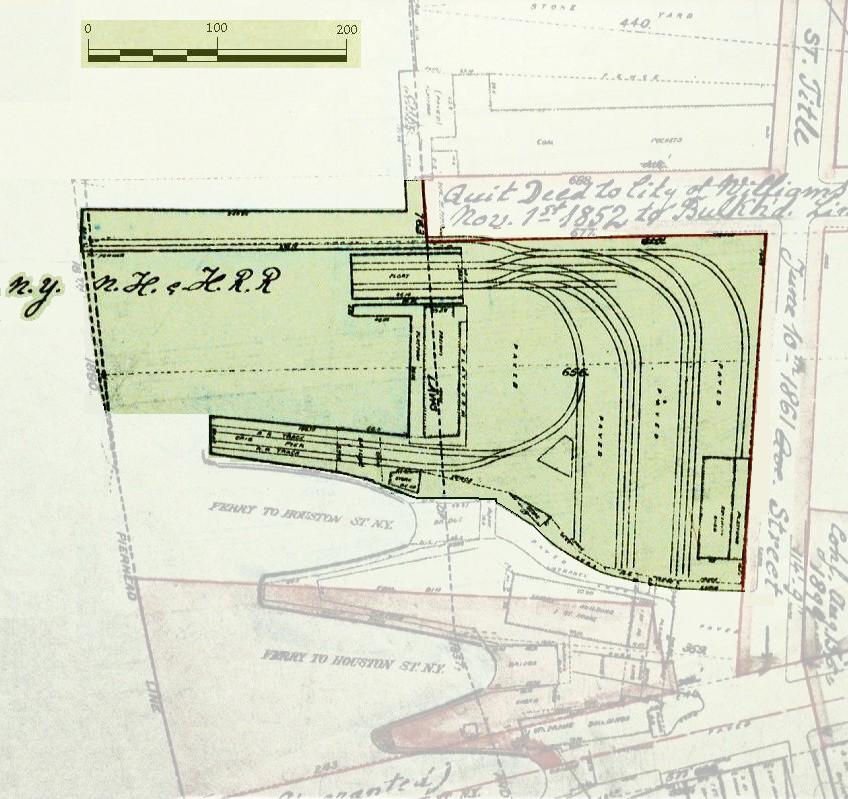
1902 - City of New York Department of Docks Atlas
courtesy of T. Flagg
.
.
.. In the "Report of the Committee on Terminals and Transportation", published 1913; a discussion on the expansion of existing terminals (in 1903) and those built after that date; states, "the new stations are few" and along with several other "new" freight terminals, it goes on to list the New York, New Haven & Hartford Railroad's North 1st Street Freight Station being operated after 1903. It lists freight station capacity at this facility in 1913 being 12,010 square feet.
In the 1913 Brooklyn Daily Eagle Almanac and the August 27, 1915 issue of Railway Age Gazette, it lists for the New York, New Haven & Hartford Railroad, having a freight station at the foot of North 1st Street.
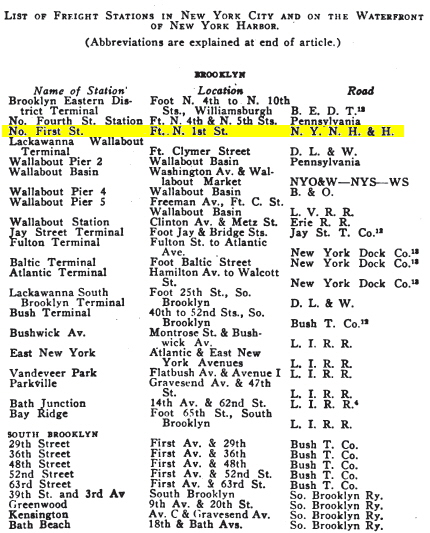
List of Freight Terminals, 1914
August 27, 1915 issue of Railway Age Gazette
.
.
|
|
.
.
Oddly, the 1907 G. W. Bromley map reflects only a single structure between to the piers and just south of the float bridge. I noticed that the bulkhead at this point protrudes out into the water as if the float bridge was still in place.
A paragraph in the Railway Age Gazette, October 13, 1911 reads:
"Brooklyn. N. Y.: A pier has been constructed and is in service at North First Street, Brooklyn; providing a terminus for freight distribution in connection with car float service to New York."
(Unfortunately, it does not denote which pier has been built, and the maps above show two piers both before and after this date.)
.
By the 1916 Belcher Hyde Map seen above right, all trackage from this facility has now been removed, the float bridge removed (and the bulkhead now indented towards River Street) and an adjoined structure (also shown as iron as covered) is shown directly in front of (east) where the float bridge was located.
The second image received from Tom Flagg, is a railroad facilities map from the 1917 Official Register of Railway Equipment. It still shows the New York, New Haven & Hartford Railroad having a presence in Williamsburg, Brooklyn; which at this time is believed to be pier station only.
Interestingly enough, this map also now shows that the Brooklyn Eastern District Terminal is an agent for the New York, New Haven & Hartford as well!
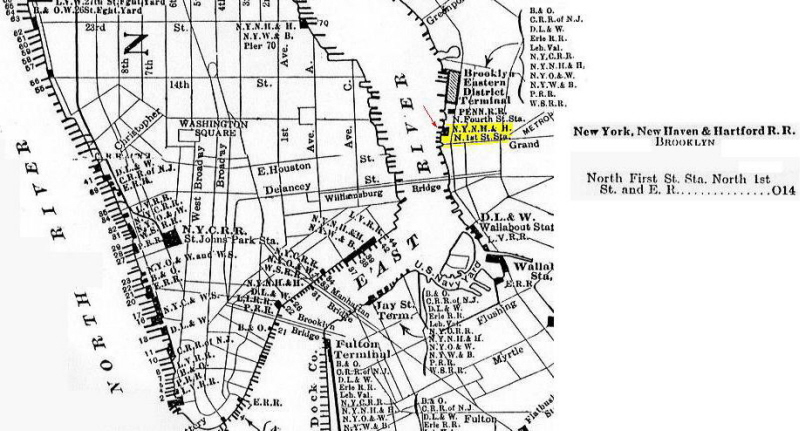
1917 Official Register of Railway Equipment
courtesy of T. Flagg
.
.
An "iron covered building" (as denoted by the 1916 Belcher Hyde Map Legend) is shown to be located on the pier at the foot of North 1st Street. This building can be seen in the 1924 Fairchild Aerial Survey Photo below. However, it is unknown (and doubtful) if the New York, New Haven & Hartford Railroad was still occupying the pier or structure at this date.
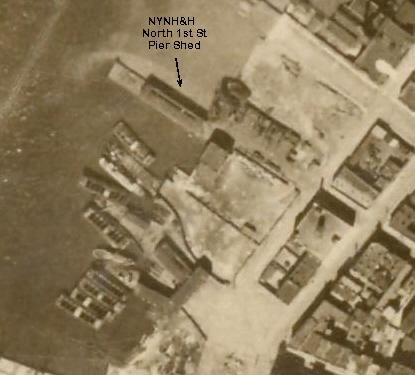
1924 Fairchild Aerial Survey Photo
NYPL Digital Archives
. .
On 13 March 2010, our esteemed co-author and "man about the web" Joe Roborecky, located a website which held digital .pdf scans of issues of the long out of print Brooklyn Daily Eagle newspaper. He naturally commenced on a search for "Brooklyn Eastern District Terminal" and forwarded those findings. I continued searching into the wee hours of the morning and fortunately the following newspaper article contained that term, but more importantly the article contained vital information regarding the New York, New Haven & Hartford Railroad's North 1st Street Freight Station!
|
For starters, this newspaper article bears out my stated
hypothesis above, that:
"If one takes note, the property lease above was for ten years, with options for two additional ten year leases: 1918 - 1928 and 1928 - 1938." . As we can now tell by the date of this newspaper article, the New York, New Haven & Hartford apparently did not renew their lease and closed the yard in 1918! As it also turns out; Tom Flagg was right on the mark when he forwarded his reasons for the yards closure: "Offline railroad terminal operations inherently cost more to operate. With Brooklyn Eastern District Terminal only four blocks north, perhaps the New York New Haven & Hartford Railroad could not justify the expenses of operating this terminal, even though their tugboats and carfloats would pass this location enroute to their Oak Point Facility in the Bronx." . The article contains a statement issued by the Federal Manager of the New York, New Haven & Hartford Railroad. Some of you may be asking; why a Federal Manager? Keep in mind that at the time New York, New Haven & Hartford Railroad announced that it would cease operation at North 1st Street; the United States was embroiled in World War I. If I understand correctly, the railroads in the United States fell under the jurisdiction of the United States Railroad Administration during this time period. The United States Railroad Administration ultimately would make a final determination as to the cessation of service, to ensure it did not impact adversely upon either the economy or impede upon freight handling and shipments for the war effort. Returning to that statement issued by E. J. Pearson, he stated: "The use of pier at foot of N. First st. was discontinued in the interest of economy, the gross revenues not being far from the costs of operating the pier, as well as due to the fact the business handled there could just as well be handled at the Brooklyn Eastern District Terminal, which is situated within two or three block of the North First Street Terminal." . This is not to say the consignees and customers loyal to the New York, New Haven & Hartford Railroad's North 1st Street Freight Station did not agree with this determination and besides a great deal of correspondence, they filed a petition to restore service. Brooklyn railroading history reflects they were not successful. This article is also of some logistical importance, as I infer by its context that railroad service (rail - marine transfer) at this location had already been discontinued and the service remaining was pier station / steamship only. |
.
.
And so with this latest discovery, we can now safely come to the conclusion that the New York, New Haven & Hartford Railroad vacated the Williamsburg waterfront in 1918, leaving the Pennsylvania Railroad and Brooklyn Eastern District Terminal to service the Greenpoint / Williamsburg customers requiring freight service.
.
At this time, it is not known what locomotives operated at this facility, but I feel it can be safely concluded they were all steam powered.
Also, as this location was inhabited by two different railroads at two separate times, necessitates the need for two separate rosters.
.
Baltimore & Ohio Railroad
There are several sidetank / saddletank entries for the Baltimore & Ohio Railroad in the builders records I have at my disposal. Also of great convenience was my copy of "B&O Power" by Lawrence W. Sagle & Alvin Staufer and published in 1964.
The Baltimore & Ohio Railroad had a prolific roster of 0-4-0T switchers even from the "early days" prior to 1900. Fortunately these locomotives are well documented, so it was rather easy to assemble a list of potential candidates of locomotives that might have been used at North First Street.
I did not compile a list of the 0-6-0T locomotives used by Baltimore & Ohio Railroad, as due to the very small confines of the North 1st Street Terminal, it seems unlikely that use of a 0-6-0 locomotive was applicable.
It seems logical, but unconfirmed; that locomotives would be transferred to and from this facility upon necessary repair or servicing; so it is very likely more than one locomotive served this facility over the years. Therefore I have listed all applicable candidates.
Please note: the widely recognized and
well known Baltimore & Ohio Railroad 0-4-0T saddletank locomotives #96,
97, 98, 99, better known as "Little Joes";
were not built until 1912, long after Baltimore & Ohio RR vacated the
North 1st Street location and are therefore not included in the roster
below.
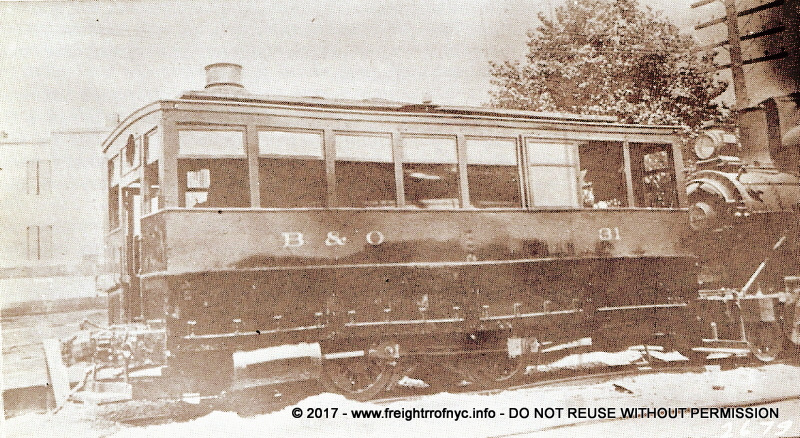
#31 - unknown date - unknown location
As steam dummy for use on Pratt Street.
unknown photographer
no province listed
B&O Power by Lawrence W. Sagle & Alvin Staufer,
1964
added 14 March
2010
.
.
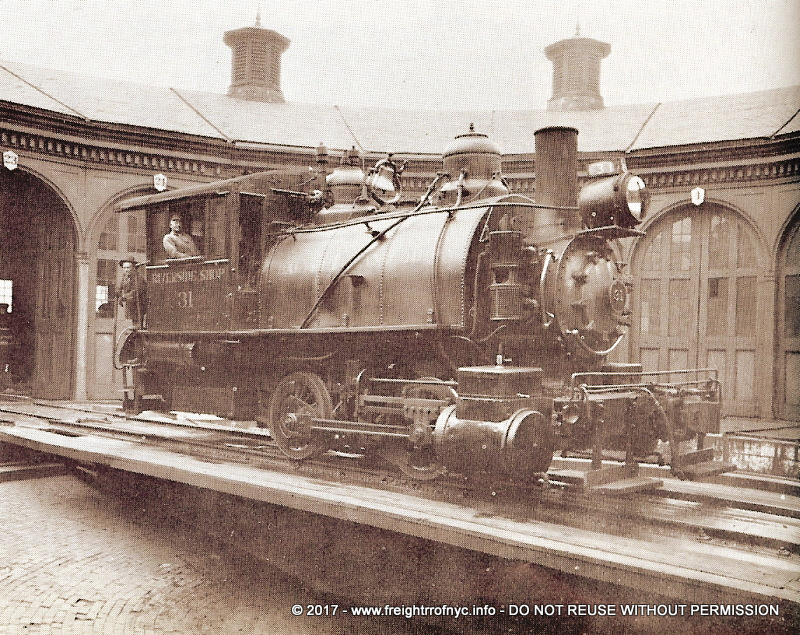
#31 - unknown date - Baltimore & Ohio RR Riverside
Shops, Baltimore, MD
Rebuild as conventional saddletank locomotive.
unknown photographer
Baltimore & Ohio Railroad
B&O Power by Lawrence W. Sagle & Alvin Staufer,
1964
added 14 March
2010
.
.
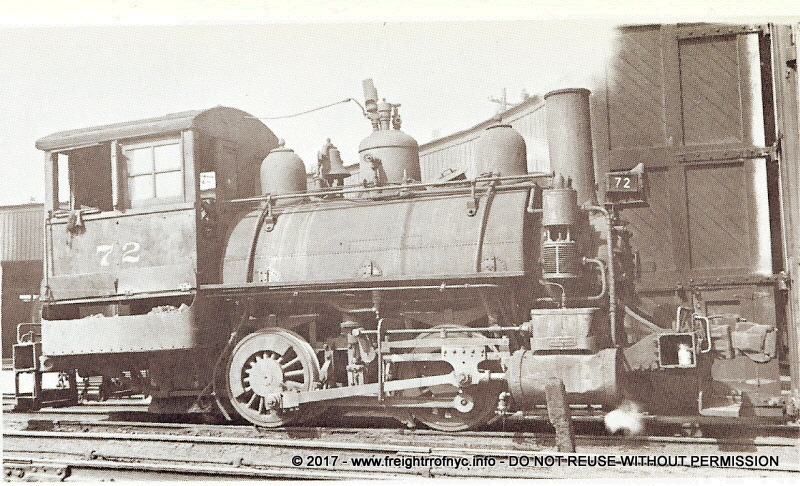
#72 - unknown date - Baltimore & Ohio RR Mt. Clare
Shops
unknown photographer
Baltimore & Ohio Railroad
B&O Power by Lawrence W. Sagle & Alvin Staufer, 1964
added 14 March
2010
.
.
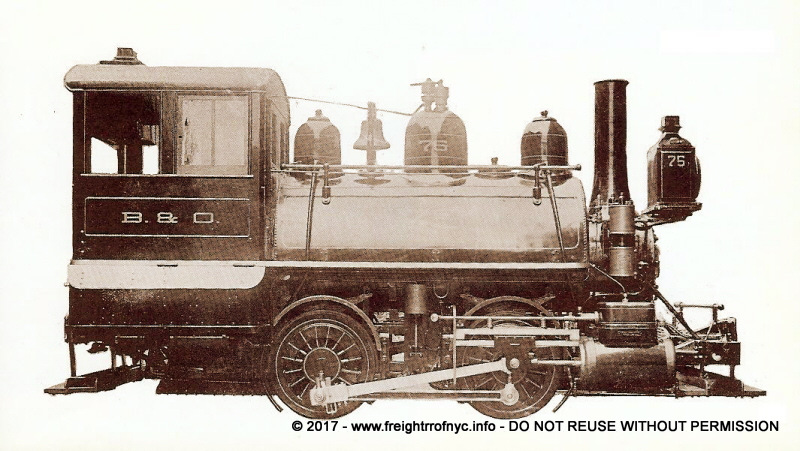
#75 - unknown date - Baltimore & Ohio RR Mt. Clare
Shops
unknown photographer
H. Broadbelt collection
B&O Power by Lawrence W. Sagle & Alvin Staufer,
1964
added 14 March 2010
.
.
North First Street Freight
Station (B&O RR) Steam Locomotive Roster
| number / name | builder |
c/n |
build date |
gauge |
wheel arrangement |
wheel dia |
cylinders |
weight |
tractive |
boiler |
acquired |
disposition |
notes |
ref |
| 392 / 5 393 / 6 |
Danforth | 1873 | std. | 0-4-0T | 43" | 12" x 22" | retired 1900 | B&O Class C-8 | [17] | |||||
| 30 | Baldwin | 4445 | 10/ 1878 | std. | 0-4-0T | 43" (48"?) |
14" x 22" | used 1902 | sold August 1899 | B&O Class C-7 ex-Valley Railway 1 "James Farmer" RR name change 10/95 to Cleveland Terminal & Valley #1 |
[2] [17] |
|||
| 24 | Pittsburgh | 8601 | 1886 | std. | 0-4-0T | 43" | 14" x 22" | new | retired 1908 | B&O Class C-2 | [4] [17] |
|||
| 27 | Pittsburgh | 8701 | 1887 | std. | 0-4-0T | 43" | 14" x 22" | 65,600 | 12,788 | 150 psi | new | retired 1916 | B&O Class C-3 | [4] [17] |
| 28 | Pittsburgh | 8702 | 1888 | std. | 0-4-0T | 43" | 14" x 22" | 66,000 | 13,974 | 150 psi | new | #28 retired 1887 | B&O Class C-4 | [4] [17] |
| 29 | Pittsburgh | 8803 | 1888 | std. | 0-4-0T | 43" | 14" x 22" | 66,000 | 13,974 | 150 psi | new | #29 retired 1888 | B&O Class C-4 | [4] [17] |
| 31 | B&O | 1890 | std. | 0-4-0T | 44 | 18" x 24" | 85,820 | 23,283 | 155 psi | new | scrapped 1933 | B&O Class C-6 steam dummy for Pratt St. Baltimore, MD; rebuild to conventional locomotive unknown year; |
[17] | |
| 71 | Baldwin | 13372 | 4/1893 | std. | 0-4-0T | 44" | 14" x 24" | 68,000 | 12,500 | 160 psi | new | scrapped 1929 |
B&O Class C-4/44 | [2] [17] |
| 72 | Baldwin | 13373 | 4/1893 | std. | 0-4-0T | 44" | 14" x 24" | 68,000 | 15,900 | 175 psi | new | re# 318, 1944 | B&O Class C-4/44 | [2] [17] |
| 73 | Baldwin | 13374 | 4/1893 | std. | 0-4-0T | 44" | 14" x 24" | 68,000 | 15,900 | 175 psi | new | sold to Alton RR, scrapped 1/48 | B&O Class C-4/44 | [2] [17] |
| 74 | Baldwin | 13375 | 4/1893 | std. | 0-4-0T | 44" | 14" x 24" | 68,000 | 15,900 | 175 psi | new | sold 1928 | B&O Class C-4/44 | [2] [17] |
| 75 | Baldwin | 13376 | 4/1893 | std. | 0-4-0T | 44" | 14" x 24" | 68,000 | 15,900 | 175 psi | new | scrapped 1931 | B&O Class C-4/44 | [2] [17] |
New York, New Haven Hartford Railroad
Pertaining to locomotives of the New York New Haven & Hartford Railroad, that were applicable size for operation at North 1st Street; most are of 0-4-4T wheel arrangement, which I believe was a common wheel arrangement for use in elevated and suburban passenger service.
The only 0-4-0T entry is Rhode Island Locomotive Works c/n #1191, built February 1882 was originally numbered 31. Renumbered 331 in 1893, renumbered again to 2120 in 1904 and sold to Southern Iron & Equipment (locomotive dealer) in August 4, 1905.
Please keep in mind it is unconfirmed if this locomotive actually operated at the North 1st Street Freight Station, but at this is the only 0-4-0T entry for New York New Haven & Hartford that I have found to date, I have listed it here.
North First Street Freight Station (NYNHHRR)
Steam Locomotive Roster
| number / name | builder |
c/n |
build date |
gauge |
wheel arrangement |
wheel dia |
cylinders |
acquired |
disposition |
notes |
ref |
| 2120 | Rhode Island | 1191 | 2/1882 | std. | 0-4-0T | 52" | 16" x 20" | used | sold 8/4/1905 | unconfirmed if use at N1st
Street NYP&B# 31 "Seaside" re# 1893: NYNH&H #331 re# 1904: #2120 |
[9] |
.
.
As both the Baltimore & Ohio and New York New Haven & Hartford Railroads operated vast pools of marine equipment, to include tugboats carfloat, covered barges and lighters, it is unlikely either of these railroads had a specific vessel assigned to this North 1st Street Freight Station.
Therefore, a marine roster is not forthcoming.
Like what you see? Suggestions?
Comments?